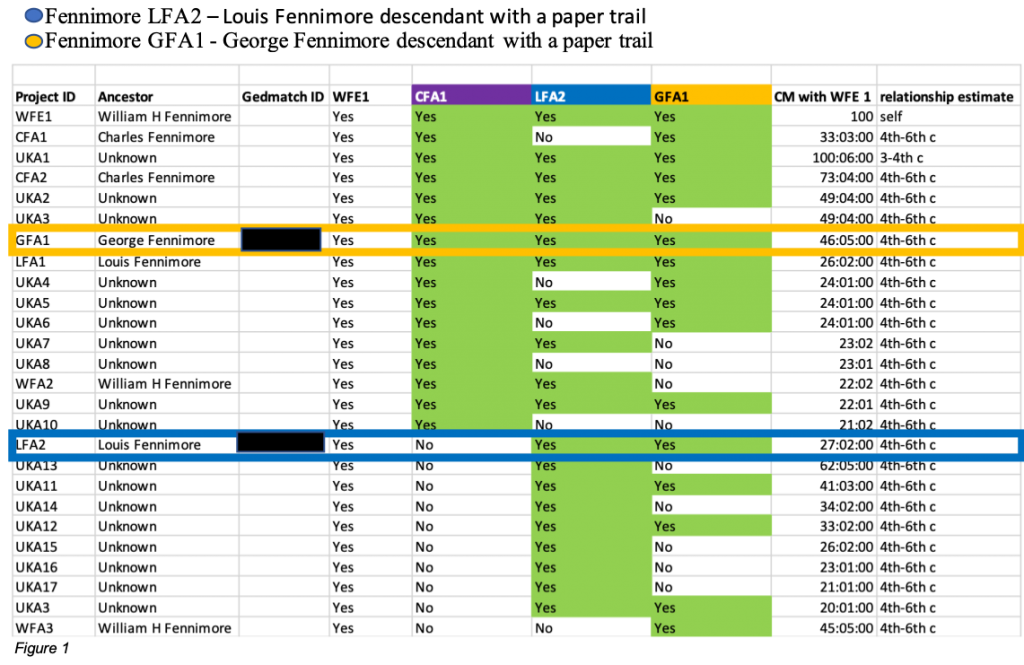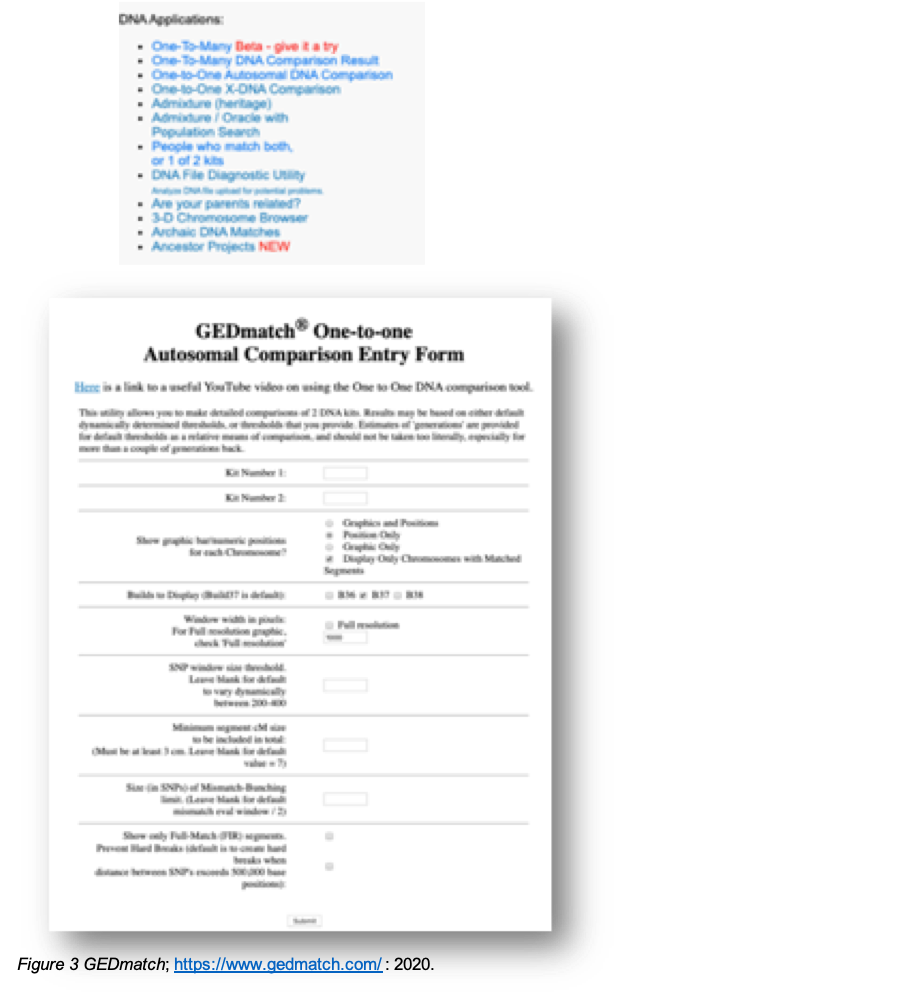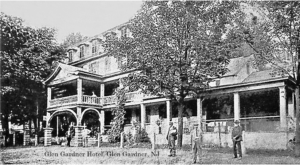Gedmatch is a third-party tool, it doesn’t test your DNA, but can be used to compare your raw data with other participants from several testing companies. It’s been out there for a long time, so I will only be covering the basics and how I use it for my project. There is plenty of training available on how to use the tool, and why you would do it. Basically, you download your raw DNA data and upload it to Gedmatch. In my case, I used my Ancestry kit. There you can easily perform analysis on your matches from different testing companies. There are three key points to consider before pushing that button to download the DNA.
- Do you have the authorization to move this kit? Is it your personal kit? Then that is an easy answer, yes. If it is a kit you manage for someone else, then you need to get their permission in a manner where they understand the implications fully. Ideally, in writing.
- Are you ready to put your raw data out into the “wild?” Kind of joking but kind of not. Make sure you understand the company’s privacy policy. Read up on how they caught the Golden State Killer (and many others), and you will understand. Gedmatch has been used by law enforcement and forensic genealogists to match DNA from crime scenes. Another matter is data breaches; however, no company is immune and, that should be a consideration before taking any DNA test. It’s a very personal decision, which may evolve over time.
- Can you handle surprises? Some findings can’t be unknown. Occasionally a break in the DNA of a family tree becomes apparent. The obvious “surprise” would be that you find that one of your parents is not your biological parent, or a new half-sibling is discovered. It can also be an event in your extended family, as well. Let’s say that your 1st cousin Willy took an Ancestry test, and you notice that he has some very close matches that no one in the family share. Are you going to tell Willy? Everyone, should, of course, consider this before taking a DNA test.
Informed consent is key to any project when you request family to take a test. Privacy issues acknowledged, and permission should be obtained. Additionally, determine whether test-takers want to be informed if “surprises” are found.
Alright back to the point of the post. This weekend I dusted off my Gedmatch profile and ran a “one to many comparison.” This utility compares your test, to other kits that share DNA over a certain threshold. The default is 7cm, so the match must be greater than that size to appear on the report, but you can change it to your liking. This is report provides all of my matches; maternal, paternal, etc. I need to be able to isolate some kits that I know are Fennimore descent and perform a 1:1 comparison to each.
Once I get the list, also save it to excel, I add the date to my file name. If you run this utility once a month, you can track new matches a little easier. Also, some people will take their kit private or delete it altogether, so it’s essential to preserve the data and contact information while it’s available.
Once I get this list, I take a look at user names. I find two kits which I am reasonably sure are two Fennimore matches in Ancestry. In my project tracker, they are labeled as GFA1 and LFA2. I lucked out on this one. These are known matches to me that have a paper trail. We cover three children of the base couple of William Fennimore and Mary Day. I find a third match that I am relatively sure that I have emailed with during the years, but her kit isn’t public in Ancestry at this time. For now, I will start with the two I know.
I use the group function in Ancestry, where I track my DNA matches that can be paired to a particular 2nd generation via traditional genealogy. Two Gedmatch kits happen to be already grouped with traditional genealogy; as I’ve said, I have been researching for years.

I then update my project tracker with our common matches; I am WFE1. There is also a descendant of Charles Fennimore, but I am unsure whether that individual has moved their kit to Gedmatch; important information but not relevant for this exercise yet. The Gedmatch ID has been matched to my tracking sheet above (the black boxes).
Below is the “one to many report,” which has been exported to excel. I have highlighted kits which I have matched to known testing company users with green and filtered them out. There will be more in the future, but we have these two as a beginning.
I have obscured their personal information (even though it is public). Usually, you would see a Gedmatch Kit ID, user name, and email. The Gedmatch Kit ID has been matched to my tracking sheet above (the black boxes)

My next step is to validate the match and see which DNA we share. So I will select the Gedmatch one-to-one autosomal DNA Comparison with each kit.:

There are many options to view, I like to cut out the clutter, so I choose Position Only for matched segments:
The first kit I try has matches on two chromosomes. The second kit has three chromosomes, different than my match to the first kit. When I compare these two kits, they have matches over 5 segments. One match is the chromosome I have in common with both, but not in the same segments. In the past, I would have used excel to map out this data, but instead, I will be using DNA painter.
Meanwhile, I have gathered the list of matches that I have in common with each kit and entered them on my tracker. They may already be listed because many are imports from Ancestry, but I can’t connect them at this time. I will be merging them later if I receive responses to requests.
You may wonder why I am not yet contacting my matches. The reason is that I want to target the matches that will most likely be able to solve my riddle. I’m just not quite ready to start involving people until I have a plan of attack. This is just a beginning, there are other testing companies that I have kits in. Also, although I am calling this Fennimore DNA, it is really the match to a couple. It may make sense to try to eliminate the DAY segments to get a better target. William and Mary were my third great grandparents, so it is a bit removed at this point.
I will continue this process with my tests in 23andme, Family Tree DNA, and My Heritage. Each company will have unique testers and some overlap. Some test takers use the same ID for each company; others do not. I can sleuth some out based on email IDs, or similar IDs. I will leverage Gedmatch for Ancestry kits because that company does not provide the specific location of matches. This is going to be important for future analysis in DNA Painter. In conclusion, I have considered privacy and permission, and how it will be handled going forward. I have also started an overall project structure so that I can have better control over the data and traditional research. DNA matches alone will not solve this riddle.
References:
GEDmatch – Tools for DNA and Genealogy Research ©Copyright 2011-2020 by GEDmatch, Inc.
Ancestry – © 1997-2020 Ancestry
23and Me – © 2020 23andMe, Inc.
DNA Painter – © DNA Painter, 2020



